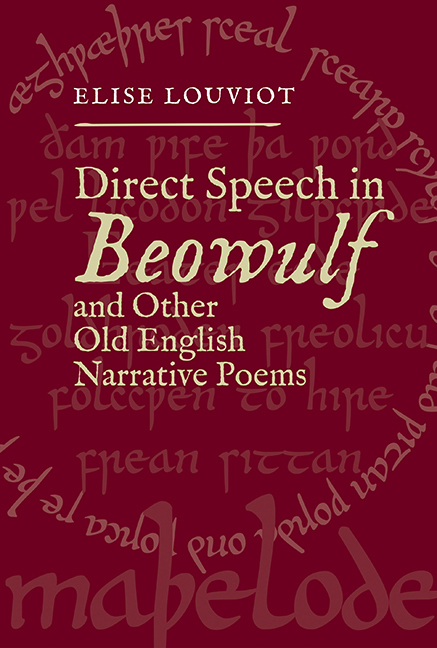Book contents
- Frontmatter
- Contents
- List of Figures
- Acknowledgements
- Introduction
- 1 The Form of Direct Speech
- 2 The Content and Context of Direct Speech
- 3 A Lack of Subjectivity?
- 4 Archetypal Subjectivity
- 5 A Problem with Voices
- 6 A Problem with Point of View
- 7 Impossible Irony
- Conclusion
- Bibliography
- Index
- Anglo-Saxon Studies
2 - The Content and Context of Direct Speech
Published online by Cambridge University Press: 05 June 2016
- Frontmatter
- Contents
- List of Figures
- Acknowledgements
- Introduction
- 1 The Form of Direct Speech
- 2 The Content and Context of Direct Speech
- 3 A Lack of Subjectivity?
- 4 Archetypal Subjectivity
- 5 A Problem with Voices
- 6 A Problem with Point of View
- 7 Impossible Irony
- Conclusion
- Bibliography
- Index
- Anglo-Saxon Studies
Summary
Hart, Bartlett and Klaeber, quoted in the Introduction (‘Traditional Views on Direct Speech’), ascribe the lack of interaction in Old English poetic speeches to a taste for formality and ceremony. According to them, poets enjoy speeches for their own sake and not for what they may contribute to the action of the poem. While some elements of that diagnosis are undoubtedly true, especially regarding Beowulf, others need to be revised. This chapter reassesses the three major contentions of the ‘traditional’ view on Direct Speech in Old English poetry: that it is too formal, that it is ceremonial and that it impedes action.
Excessive Formality
The notion that lack of dynamism in Old English poetic speeches is due to their excessively formal style is only partly based on fact. It is true that some characteristic elements of Old English poetic style tend to slow down the pace of speeches, and those elements will be considered briefly below. First, however, it is important to acknowledge a number of modern preconceptions that may alter our perception of the issue.
Formality and Orality
Paradoxically, even though Old English poetic speeches are the product of a tradition steeped in orality, they may appear very ‘written’ to a modern reader because of their great stylistic elaboration. The connection between writing and greater sophistication is far from universal, however. It feels natural to us because we live in a society in which writing has a quasi-monopoly on ‘serious’ communication, including literature. Admittedly, from the very beginning, writing was used to preserve texts that were felt to deserve, more than others, that additional effort and material. Even so, oral transmission long remained legitimate for all speech acts, from the most humble to the most highly respected. Originally, all discourse was oral and writing was merely a marginal technique of preservation. Writing only very gradually developed to the point where it became even possible to think of orality and literacy as a dichotomy. The evolution of the representation of speech in literature is directly connected to the change in the respective status of orality and literacy.
- Type
- Chapter
- Information
- Publisher: Boydell & BrewerPrint publication year: 2016



